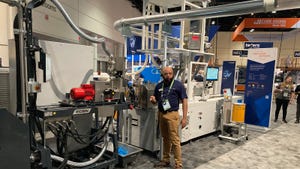Simulation software accelerates design of reinforced-plastic parts
An OEM version of Moldex3D embedded in Digimat-RP for injection molding simulation has been launched by e-Xstream engineering (Luxembourg), a wholly owned subsidiary of MSC Software. The system provides structural CAE engineers with an estimate of fiber orientation for finite element analysis (FEA). The fiber orientation estimate within Digimat-RP is based on fully integrated Moldex3D technology for meshing, flow simulation and fiber orientation computation.
November 17, 2015
An OEM version of Moldex3D embedded in Digimat-RP for injection molding simulation has been launched by e-Xstream engineering (Luxembourg), a wholly owned subsidiary of MSC Software. The system provides structural CAE engineers with an estimate of fiber orientation for finite element analysis (FEA). The fiber orientation estimate within Digimat-RP is based on fully integrated Moldex3D technology for meshing, flow simulation and fiber orientation computation.
Digimat-RP/Moldex3D benefits from the recognized integrative technology of Digimat-RP, allowing easy and accurate nonlinear analysis of reinforced plastic parts through advanced non-linear micro-mechanical material models and an intuitive user interface, according to the company. It enables multiple process and design iterations for part optimization to be performed in one day.
"With the coupling of advanced technologies of Moldex3D for injection molding processes and Digimat-RP for nonlinear multi-scale structural modeling, it is now possible for an accurate description of the local composite behavior for inclusion in FEA simulation," said Dr. Venny Yang, President, CoreTech System (Moldex3D). Seamless CAE validation workflow helps users to design better fiber-reinforced plastic parts in a faster and more robust manner, added Yang.
"The design of reinforced plastic parts is traditionally based on a ‘black metal' approach, where the plastic behavior is highly approximated resulting in over-designed and too-heavy parts," said Dr. Roger Assaker, CEO, e-Xstream engineering. "This is due to the lack of process information and efficient tools enabling structural engineers to account for actual material behavior in the early design stages. This is today solved with Digimat-RP in general and with the integration of Moldex3D within Digimat-RP."
About the Author(s)
You May Also Like

